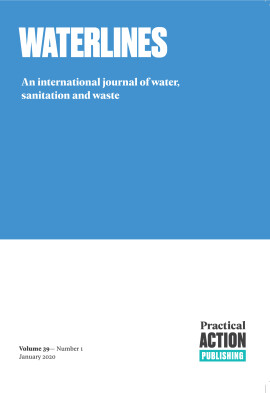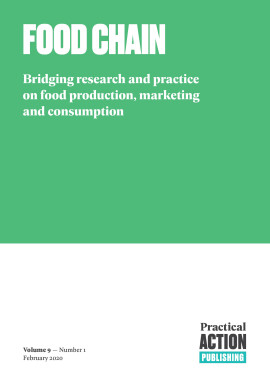Beyond building: how social norms and networks shape mason construction practices in incremental homebuilding
Scott Merrill | Erin Markel | Adriano Scarampi | Meghan Bolden | Sheldon Yoder
How do low-income households and masons make house construction decisions? A three-country study examined social norms, networks, and information flows that influence construction practices in Kenya, India, and Peru. The study used a suite of qualitative research strategies, including desk research, site observation, focus group discussions, and key informant interviews, to examine households and informal construction service providers, and the interactions between them. The research sought to answer the following questions: 1) How do households and individuals make housing decisions? 2) What are the information flows, key influences, and social norms that steer these decisions? and 3) How can programmes leverage knowledge about norms to improve the quality of home construction? Findings covered areas of gender, disaster resilience, and construction labour – this article focuses on the latter. Ultimately the paper argues that designing impactful programmes for low-income housing markets requires understanding and incorporating these social norms, networks, and information flows.Acolin, A. and Hoek-Smit, M. (2020) Cornerstone of Recovery: How Housing Can Help Emerging Economies Rebound from COVID-19 [online], Habitat for Humanity International <https://www.habitat.org/sites/default/files/Cornerstone%20of%20Recovery_Oct.%202020.pdf> [accessed 26 May 2021].
Bicchieri, C., Lindemans, J. and Jiang, T. (2014) ‘A structured approach to a diagnostic of collective practices’, Frontiers in Psychology 5: 1418 <https://dx.doi.org/10.3389%2Ffpsyg.2014.01418>.
Campbell, R. (2014) ‘A framework for inclusive market system development’ [online], USAID <https://www.marketlinks.org/sites/default/files/resource/files/Market_Systems_Framework.pdf> [accessed 26 May 2021].
Cislaghi, B. and Heise, L. (2016) ‘Measuring gender-related social norms: report of a meeting’, Baltimore Maryland, 14–15 June 2016, Learning Group on Social Norms and Gender-based Violence of the London School of Hygiene and Tropical Medicine.
Cislaghi, B. and Heise, L. (2018) ‘Theory and practice of social norms interventions: eight common pitfalls’, Global Health 14: 83 <https://doi.org/10.1186/s12992-018-0398-x>.
Goethert, R. (2010) ‘Incremental housing: a proactive urban strategy’ [online], Monday Developments <http://web.mit.edu/incrementalhousing/articlesPhotographs/pdfs/PagesMondayMag.pdf> [accessed 26 May 2021].
Klassen, M., Shakya, H., Cislaghi, B., Markel, E., Merrill, S., Jenal, M., Vasudevan, R. and Garloch, A. (2017) ‘Social norms in market systems development: a practitioner-led research brief’ [online], BEAM Exchange <https://beamexchange.org/resources/983/> [accessed 26 May 2021].
Markel, E., Gettliffe, E., Jones, L., Miller, E. and Kim, L. (2016) ‘The social norms factor: How gendered social norms influence how we empower women in market systems development’ [online], BEAM Exchange <https://beamexchange.org/resources/797/ [accessed 26 May 2021].
MarketShare Associates (2016) Disrupting System Dynamics: A Framework for Understanding Systemic Changes, LEO Report no. 47, USAID, Washington, DC.
MarketShare Associates (2017a) Value Network Analysis and Influencer Diagnostic (VNID) Tool [online] <https://marketshareassociates.com/value-network-and-influencer-diagnostic-vnid-tool/> [accessed 9 August 2021].
MarketShare Associates (2017b) Behavioral Analysis and Norms Diagnostic (BAND) Tool [online] <https://marketshareassociates.com/behavioral-analysis-norms-diagnostic-tool/> [accessed 9 August 2021].
MarketShare Associates (2020) Gendered Social Norms in Financial Inclusion [online], CGAP Background Documents <https://www.findevgateway.org/paper/2020/07/gendered-social-norms-financial-inclusion> [accessed 26 May 2021].
Scarampi, A. (2019) Beyond Building: How Social Norms Shape Low-Income Home Construction in India [online], Habitat for Humanity International <https://www.habitat.org/sites/default/files/documents/Habitat%20Social%20Norms%20Report-India-FINAL.pdf> [accessed 26 May 2021].
Shakya, H.B., Christakis, N.A. and Fowler, J.H. (2014) ‘Association between social network communities and health behaviour: an observational sociocentric network study of latrine ownership in rural India’, American Journal of Public Health 104(5): 930–7 <https://doi.org/10.2105/AJPH.2013.301811>.
Stefanik, L. (2016) ‘Applying social norms theory for measurement’, presentation at American Evaluation Association Conference, Atlanta, GA, 27 October 2016.
Stefanik, L. and Hwang, T. (2017) Applying Theory to Practice: CARE’s Journey Piloting Social Norms Measures for Gender Programming [online], CARE <https://prevention-collaborative.org/wp-content/uploads/2018/04/applying_social_norms_theory_to_practice_cares_journey.pdf> [accessed 26 May 2021].
Vasudevan, R. (2019) Beyond Building: How Social Norms Shape Low-Income Home Construction in Kenya [online], Habitat for Humanity International <https://www.habitat.org/sites/default/files/documents/Habitat%20Social%20Norms%20Report-Kenya-Final.pdf> [accessed 26 May 2021].
Villaviciencio, N. (2019) Beyond Building: How Social Norms Shape Low-Income Home Construction in Peru [online], Habitat for Humanity International <https://www.habitat.org/sites/default/files/documents/Habitat%20Social%20Norms%20Report-Peru-FINAL.pdf> [accessed 26 May 2021].
Acolin, A. and Hoek-Smit, M. (2020) Cornerstone of Recovery: How Housing Can Help Emerging Economies Rebound from COVID-19 [online], Habitat for Humanity International <https://www.habitat.org/sites/default/files/Cornerstone%20of%20Recovery_Oct.%202020.pdf> [accessed 26 May 2021].
Bicchieri, C., Lindemans, J. and Jiang, T. (2014) ‘A structured approach to a diagnostic of collective practices’, Frontiers in Psychology 5: 1418 <https://dx.doi.org/10.3389%2Ffpsyg.2014.01418>.
Campbell, R. (2014) ‘A framework for inclusive market system development’ [online], USAID <https://www.marketlinks.org/sites/default/files/resource/files/Market_Systems_Framework.pdf> [accessed 26 May 2021].
Cislaghi, B. and Heise, L. (2016) ‘Measuring gender-related social norms: report of a meeting’, Baltimore Maryland, 14–15 June 2016, Learning Group on Social Norms and Gender-based Violence of the London School of Hygiene and Tropical Medicine.
Cislaghi, B. and Heise, L. (2018) ‘Theory and practice of social norms interventions: eight common pitfalls’, Global Health 14: 83 <https://doi.org/10.1186/s12992-018-0398-x>.
Goethert, R. (2010) ‘Incremental housing: a proactive urban strategy’ [online], Monday Developments <http://web.mit.edu/incrementalhousing/articlesPhotographs/pdfs/PagesMondayMag.pdf> [accessed 26 May 2021].
Klassen, M., Shakya, H., Cislaghi, B., Markel, E., Merrill, S., Jenal, M., Vasudevan, R. and Garloch, A. (2017) ‘Social norms in market systems development: a practitioner-led research brief’ [online], BEAM Exchange <https://beamexchange.org/resources/983/> [accessed 26 May 2021].
Markel, E., Gettliffe, E., Jones, L., Miller, E. and Kim, L. (2016) ‘The social norms factor: How gendered social norms influence how we empower women in market systems development’ [online], BEAM Exchange <https://beamexchange.org/resources/797/ [accessed 26 May 2021].
MarketShare Associates (2016) Disrupting System Dynamics: A Framework for Understanding Systemic Changes, LEO Report no. 47, USAID, Washington, DC.
MarketShare Associates (2017a) Value Network Analysis and Influencer Diagnostic (VNID) Tool [online] <https://marketshareassociates.com/value-network-and-influencer-diagnostic-vnid-tool/> [accessed 9 August 2021].
MarketShare Associates (2017b) Behavioral Analysis and Norms Diagnostic (BAND) Tool [online] <https://marketshareassociates.com/behavioral-analysis-norms-diagnostic-tool/> [accessed 9 August 2021].
MarketShare Associates (2020) Gendered Social Norms in Financial Inclusion [online], CGAP Background Documents <https://www.findevgateway.org/paper/2020/07/gendered-social-norms-financial-inclusion> [accessed 26 May 2021].
Scarampi, A. (2019) Beyond Building: How Social Norms Shape Low-Income Home Construction in India [online], Habitat for Humanity International <https://www.habitat.org/sites/default/files/documents/Habitat%20Social%20Norms%20Report-India-FINAL.pdf> [accessed 26 May 2021].
Shakya, H.B., Christakis, N.A. and Fowler, J.H. (2014) ‘Association between social network communities and health behaviour: an observational sociocentric network study of latrine ownership in rural India’, American Journal of Public Health 104(5): 930–7 <https://doi.org/10.2105/AJPH.2013.301811>.
Stefanik, L. (2016) ‘Applying social norms theory for measurement’, presentation at American Evaluation Association Conference, Atlanta, GA, 27 October 2016.
Stefanik, L. and Hwang, T. (2017) Applying Theory to Practice: CARE’s Journey Piloting Social Norms Measures for Gender Programming [online], CARE <https://prevention-collaborative.org/wp-content/uploads/2018/04/applying_social_norms_theory_to_practice_cares_journey.pdf> [accessed 26 May 2021].
Vasudevan, R. (2019) Beyond Building: How Social Norms Shape Low-Income Home Construction in Kenya [online], Habitat for Humanity International <https://www.habitat.org/sites/default/files/documents/Habitat%20Social%20Norms%20Report-Kenya-Final.pdf> [accessed 26 May 2021].
Villaviciencio, N. (2019) Beyond Building: How Social Norms Shape Low-Income Home Construction in Peru [online], Habitat for Humanity International <https://www.habitat.org/sites/default/files/documents/Habitat%20Social%20Norms%20Report-Peru-FINAL.pdf> [accessed 26 May 2021].
Acolin, A. and Hoek-Smit, M. (2020) Cornerstone of Recovery: How Housing Can Help Emerging Economies Rebound from COVID-19 [online], Habitat for Humanity International <https://www.habitat.org/sites/default/files/Cornerstone%20of%20Recovery_Oct.%202020.pdf> [accessed 26 May 2021].
Bicchieri, C., Lindemans, J. and Jiang, T. (2014) ‘A structured approach to a diagnostic of collective practices’, Frontiers in Psychology 5: 1418 <https://dx.doi.org/10.3389%2Ffpsyg.2014.01418>.
Campbell, R. (2014) ‘A framework for inclusive market system development’ [online], USAID <https://www.marketlinks.org/sites/default/files/resource/files/Market_Systems_Framework.pdf> [accessed 26 May 2021].
Cislaghi, B. and Heise, L. (2016) ‘Measuring gender-related social norms: report of a meeting’, Baltimore Maryland, 14–15 June 2016, Learning Group on Social Norms and Gender-based Violence of the London School of Hygiene and Tropical Medicine.
Cislaghi, B. and Heise, L. (2018) ‘Theory and practice of social norms interventions: eight common pitfalls’, Global Health 14: 83 <https://doi.org/10.1186/s12992-018-0398-x>.
Goethert, R. (2010) ‘Incremental housing: a proactive urban strategy’ [online], Monday Developments <http://web.mit.edu/incrementalhousing/articlesPhotographs/pdfs/PagesMondayMag.pdf> [accessed 26 May 2021].
Klassen, M., Shakya, H., Cislaghi, B., Markel, E., Merrill, S., Jenal, M., Vasudevan, R. and Garloch, A. (2017) ‘Social norms in market systems development: a practitioner-led research brief’ [online], BEAM Exchange <https://beamexchange.org/resources/983/> [accessed 26 May 2021].
Markel, E., Gettliffe, E., Jones, L., Miller, E. and Kim, L. (2016) ‘The social norms factor: How gendered social norms influence how we empower women in market systems development’ [online], BEAM Exchange <https://beamexchange.org/resources/797/ [accessed 26 May 2021].
MarketShare Associates (2016) Disrupting System Dynamics: A Framework for Understanding Systemic Changes, LEO Report no. 47, USAID, Washington, DC.
MarketShare Associates (2017a) Value Network Analysis and Influencer Diagnostic (VNID) Tool [online] <https://marketshareassociates.com/value-network-and-influencer-diagnostic-vnid-tool/> [accessed 9 August 2021].
MarketShare Associates (2017b) Behavioral Analysis and Norms Diagnostic (BAND) Tool [online] <https://marketshareassociates.com/behavioral-analysis-norms-diagnostic-tool/> [accessed 9 August 2021].
MarketShare Associates (2020) Gendered Social Norms in Financial Inclusion [online], CGAP Background Documents <https://www.findevgateway.org/paper/2020/07/gendered-social-norms-financial-inclusion> [accessed 26 May 2021].
Scarampi, A. (2019) Beyond Building: How Social Norms Shape Low-Income Home Construction in India [online], Habitat for Humanity International <https://www.habitat.org/sites/default/files/documents/Habitat%20Social%20Norms%20Report-India-FINAL.pdf> [accessed 26 May 2021].
Shakya, H.B., Christakis, N.A. and Fowler, J.H. (2014) ‘Association between social network communities and health behaviour: an observational sociocentric network study of latrine ownership in rural India’, American Journal of Public Health 104(5): 930–7 <https://doi.org/10.2105/AJPH.2013.301811>.
Stefanik, L. (2016) ‘Applying social norms theory for measurement’, presentation at American Evaluation Association Conference, Atlanta, GA, 27 October 2016.
Stefanik, L. and Hwang, T. (2017) Applying Theory to Practice: CARE’s Journey Piloting Social Norms Measures for Gender Programming [online], CARE <https://prevention-collaborative.org/wp-content/uploads/2018/04/applying_social_norms_theory_to_practice_cares_journey.pdf> [accessed 26 May 2021].
Vasudevan, R. (2019) Beyond Building: How Social Norms Shape Low-Income Home Construction in Kenya [online], Habitat for Humanity International <https://www.habitat.org/sites/default/files/documents/Habitat%20Social%20Norms%20Report-Kenya-Final.pdf> [accessed 26 May 2021].
Villaviciencio, N. (2019) Beyond Building: How Social Norms Shape Low-Income Home Construction in Peru [online], Habitat for Humanity International <https://www.habitat.org/sites/default/files/documents/Habitat%20Social%20Norms%20Report-Peru-FINAL.pdf> [accessed 26 May 2021].
Pathways of multi-hazard post-disaster housing reconstruction among Ivatan Indigenous households
Hadlos, Arvin
Opdyke, Aaron
Hadigheh, S. Ali
Gato, Charmaine
Journal of Building Engineering, Vol. 91 (2024), Iss. P.109636
https://doi.org/10.1016/j.jobe.2024.109636 [Citations: 3]- Value chain financing: evidence from Zambia on smallholder access to finance for mechanization
- Boosting financial inclusion through social assistance reform: evidence-based approach in selecting a payment system
- Developing agro-pastoral entrepreneurship: bundling blended finance and technology
- Building frontline market facilitators' capacity: the case of the ‘Integrating Very Poor Producers into Value Chains Field Guide’
- Impact of COVID-19 on livestock exports from Somalia and the Horn of Africa



